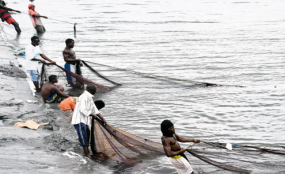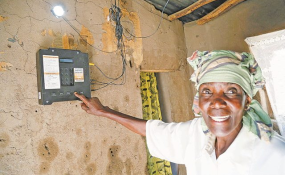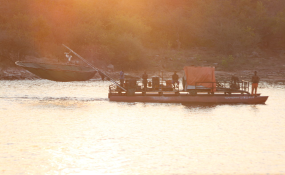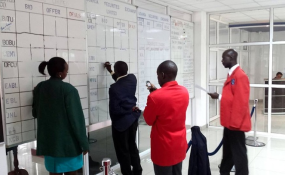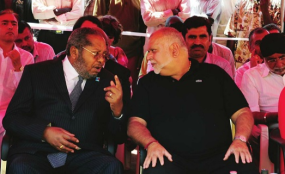By Nuzulack Dausen
Musoma — Along the shores of Lake Victoria, a young man, Mr Mwita Venance, is lying under a tree at Matvilla Beach after spending hours in the water fishing.
His colleague, Mtatiro Marwa, is busy preparing fish for a quick meal. The Nile perch he is cooking is about 20 centimetres long, and is one of the three fish they caught in the lake after a five-hour expedition.
“The situation is getting worse here,” Venance says. “In the past, it wouldn’t have taken so long to catch just three fish as there were so many in the lake. The illegal fishing is causing the scarcity.”
Venance says three years ago he used to haul between 200 and 300kg of fish each day. Nowadays, the most he catches is just 30kg. Ten times lower than what it used to be in the past.
Lake Victoria, Africa’s largest inland water body, is being over fished largely attributed to the illegal use of restricted nets, dynamite and poison used for catching fish.
Getting mature fish whether Nile perch or tilapia is proving to be more difficult as each day passes by. “We have to paddle at least 50 kms from the shore to deep waters to fish. Yet one returns with a miserable catch. If this situation continues I have no idea know how I will make ends meet,” he lamented.
Illegal fishing has adversely affected the whole supply chain. It is now difficult to get a kilo of fish in Musoma markets below Sh9,000, equivalent to what consumers pay for fish from the lake in Dar es Salaam.
Fish processing industries whether large or small are struggling to cope and a few have closed down in a bid to cut losses.
Prime Catch Exporters Ltd, once the largest fish processing factory in Mara Region halted operations two months ago due to the acute scarcity of fish.
“There was no point in continuing to run below capacity,” Irfan Jessa, Prime Catch Manager told The Citizen. The factory used to employ over 650 people.
According to Lake Victoria Fishing Organisation (LVFO), the regional body for managing fisheries on the lake, the Nile perch stock is declining faster than the other species.
LVFO data shows that between 1999 and 2001 the mean stock of Nile perch was 1.29 million tonnes annually but five years later it was down to 0.82 million tonnes.
While Prime Catch has closed down its main competitor in the region, Musoma Fish Processors Limited (MuFPL) is operating at half capacity.
A senior accountant with the MuFPL, Mr Willbald James, says the daily production capacity is 25 tonnes but due to the scarcity they are currently process only 10 tonnes. “There are times we have to wait for up to three days to get a sufficient supply for production,” he said.
According to a report from the Tanzania Fisheries Research Institute in Mwanza, the export of Nile perch started in May 1991 by Mwanza-based companies.
Principal buyers were Kenyan importers, whose equipment – such as insulated collection trucks, ice, weighing scales and selectors at landing beaches – all came from Kenya.
At this stage, at least ten small companies were involved, all of which exported whole Nile perch to Kenya for further processing and onward export to external markets, primarily Israel.
It was from these early Kenyan buyers and collectors that pioneer Tanzanian buyers learned the trade, and from whom they adopted the techniques used.
These involved the setting up informal credit schemes and incentive systems established with prominent fishers permanently resident on supply beaches.
Buyers would make regular visits to potential fishing spots where they identified fishermen with whom to establish supply arrangements. Beaches such as Mwaloni Kirumba, Kayenze, Igombe and Nyashimo became reliable Nile perch supply points.
It was through this system that dependency relationships were forged between fishers and buyers. Under these arrangements, slight delays by collection trucks represented large losses to fishers.
Since competition was, at this point, very limited, buyers were able to offer extremely low prices.
These early purchasing companies represent the fore-runners of the Nile perch filleting industry in Tanzania. Low levels of expertise and poor knowledge about the international market for fish were some of the factors, which were responsible for the slow development of the sector at that time.
Nevertheless, the establishment of factories occurred and by 1992, there were five filleting factories in Tanzania several of which had been established with Kenyan capital raised by sister companies located north of the border.
Managers within the industry at this time came from a wide diversity of occupations and backgrounds, including cargo and transportation, hotel and manufacturing, marine fish business, a journalist, a publisher, a large bakery, a poultry farmer and a shop owner. Additional expertise was obtained from Kenyan sister factories.
The early nineties, therefore, represented a transition period for the nascent Tanzanian factories during which they consolidated, trained and established their presence on the local Nile perch markets.
Difficulties were also, at this time, being encountered by the institution in charge of regulating this process, the Tanzania Fisheries Department.
Most of the problems that they encountered concerned the failure, by the processing factories, to declare correctly the value of fish exports (under-declaration of exports), failure to pay royalties and the unauthorised export of tilapia. The relations between the Fisheries Department and the fish processing factories were, in the early 1990s, relatively poor.
These difficulties were compounded by the Fisheries Department’s limited knowledge of the growing Nile perch business and the profit maximisation motives driving industrial owners resulting in the neglect of the required procedure and formalities.
Since the early 1990s the fish stock dynamics within Lake Victoria and the ecological changes that have taken place have not been well documented.
With the fish being snatched up faster than it can reproduce, the average length of caught fish tends to decrease, because fewer of them are able to survive into maturity. An audit carried out found that between 2008 and 2010, the number of fish meeting the minimum size criteria at major processing facilities around the lake dropped by more than half.
The main problem, according to the audit, is over fishing and fisheries agencies in the region have been blamed for failing to set and enforce quotas.
The Nile Perch that has dominated the lake for half a century, The predatory Nile perch was introduced into Lake Victoria by British colonial officers to restock the lake in the 1950s.
It’s driven many of the indigenous fish to extinction, earning it a reputation as an ecological disaster. For fishermen, though, it had become a cornerstone of the economy.
The current scarcity is not only affecting large industries but the small players as well. A businessman, Mr Fredrick Mtenga is seriously considering quitting the fish business as supplies have dwindled to 20 kgs per day against 500 kgs he used to sell a few years back.
“Even for the 20 kgs of fish I have to travel to Shirati about 100 kms from here,” says Mr Mtenga who has started a poultry farm in Morogoro.
Mara Regional Administrative Secretary (RAS) Adoh Mapunda says authorities have carried out patrols on the lake in collaboration with fisheries departments.
“District officials around the lake have seized and destroyed more than 3,000 restricted nets,” he said.
Despite the government’s efforts to curb illegal fishing, the alleged criminals are well-coordinated. While the authorities patrol during the day rogue fishermen operate at night. It is widely believed among residents that some security and government officials leak information to the offenders.
A former fisherman, Mr Mujungu Magesa, resident of Baruti in Musoma Municipality said, “There are informers who notify fishermen of impeding raids,”
It is at the end the supply chain of illegal fish, the government has decided to change tactics.
Musoma Municipal DirectorFidelica Myovela says they are discouraging consumers from buying fish less than 50 cm long. “We are currently carrying out patrols at markets to ensure fishmongers are not selling immature fish. We are also arresting buyers,” she says.
Some fishmongers have resorted to selling fish from their homes. To confirm this, the author of this article hired a cab at around 10 pm on November 25 and asked the taxi driver to take him to a place where he could buy fresh fish.
He was driven to four different locations where fishmongers were selling small fish under the fear of being caught.
On arrival he was advised to enquire for a “mzigo” loosely translated to English, a parcel.
To get the right type of mzigo one had to speak the local dialect, preferably Kikurya. The word sang stood for sangara for Nile perch) and sat for sato for tilapia.
The fishmonger would then signal a buyer follow in his or her house and that was how the author got his fish.
Most of the Nile perch he bought about 30 pieces, ranged between 10 to 15 cm, four times smaller than recommended size of 50 cm.
According to the United Nations’ Food and Agriculture Organisation (FAO), Nile perch (Lates niloticus) can be big as the size of a man at 200 cm and weigh 200 kgs.
As a result of the diminishing stock in the lake fish processors have joined hands with the government in discouraging fishermen from supplying immature fish.
Mr James of MuFPL says all fish processors have agreed not to buy fish below 50 cm.
“Authorities should continue monitoring illegal fishing so as to ensure fish processing industries survive because once we close the government will lose more revenues and many more will be jobless,” he said.
“Everyone should find a way of curbing illegal fishing,” Dr Mathias Igulu, a fisheries expert from an international conservation NGO, World Wide Fund for Nature (WWF) said.
“Wananchi should continue rejecting immature fish plus fish they suspect caught by using poisons or dynamite,” he stressed.
The minister of Agriculture, Livestock and Fisheries, Dr Charles Tizeba, says the government understands that most fish industries are feeling the pinch.
He says his ministry has discussed with investors on how to improve the situation. “There are public officials who are colluding with fishermen using illegal means to fish but their days are numbered. We have sacked many workers been found guilty of facilitating illegal fishing,” he said without specifying the number.
He said the government is going to amend the Fisheries Act of 2013 by adding penalties to some offences and categorise other offences as economic sabotage, which attracts tougher penalties. “We have lost a number of cases where people have used dynamite to fish because the present law doesn’t clearly define explosives. We can’t continue this way,” he said.

